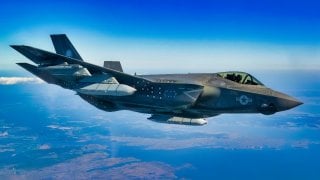F-35 Fighter Could Soon Fire 'Stealthy Munitions' at Enemy Warships
The U.S. F-35 Lightning II is preparing for a significant role shift, as recent tests show the aircraft carrying the AGM-158C Long-Range Anti-Ship Missile (LRASM). Designed to provide precise anti-ship capabilities, the LRASM offers the F-35 a powerful tool in future maritime conflicts, particularly against China in the Pacific.
Summary and Key Points: The U.S. F-35 Lightning II is preparing for a significant role shift, as recent tests show the aircraft carrying the AGM-158C Long-Range Anti-Ship Missile (LRASM). Designed to provide precise anti-ship capabilities, the LRASM offers the F-35 a powerful tool in future maritime conflicts, particularly against China in the Pacific.
-While carrying the LRASM on external pylons compromises stealth, its long-range capabilities allow the F-35 to operate from safer distances.
-The LRASM, already deployed on the F/A-18 and B-1, is now moving into full production, addressing concerns about U.S. readiness for potential naval engagements in the Indo-Pacific.
F-35 Anti-Ship Missiles Coming Soon
The venerable F-35 Lightning II has recently been spotted carrying the AGM-158C Long-Range Anti-Ship Missile (LRASM), suggesting that the fifth-generation F-35 could be taking on an anti-ship role in the future.
The LRASM, “will provide the F-35 with a powerful anti-surface warfare capability, something that will be especially important for a potential future high-end conflict in the Pacific against China,” The War Zone reported.
Testing the LRASM
The LRASM-equipped F-35 was shown in a Pentagon-released photograph recently. The photo depicted an F-35 on a test flight out of the Naval Air Station (NAS) Patuxent River, the Navy’s primary airfield for flight testing. Two LRASMs are seen, on the inboard underwing pylons of the F-35C, the Navy’s carrier-capable variant of the F-35.
“As part of ongoing integration efforts, the Pax River F-35 Integrated Test Force (Pax ITF) team flew two days of test flight to evaluate flutter, loads, and flying qualities with two AGM-158 loaded on external stations,” the photo’s caption read. “LRASM is a defined near-term solution for the Offensive Anti-Surface Warfare (OASuW) air-launch capability gap that will provide flexible, long-range, advanced, anti-surface capability against high-threat maritime targets.”
The positioning of the LRASM, on the F-35’s external pylons, is significant; externally carrying the LRASM will increase the F-35’s radar cross-section, making the jet more observable to enemy radar. But, thanks to the long-range nature of the LRASM, the trade-off will be worthwhile in certain scenarios, where the F-35 may operate beyond the range of enemy weapons, making stealth less important, while still operating within range to effectively deploy the LRASM.

The LRASM is an upgrade over the Harpoon, the anti-ship missile that has been the U.S. military’s default since its debut in 1977. The LRASM has been designed with precision routing, guidance, and stealth, according to developer Lockheed Martin, who derived the LRASM from the existing Joint Air-to-Surface Standoff Missile (JASSM).
Lockheed described the LRASM as a precision-guided intelligent anti-ship missile designed, “to interdict a variety of surface threats at very long range, navigating semi-autonomously to the target, and delivering a precise payload from safe, standoff range.” The LRASM is already in use with the F/A-18 and the B-1 with the F-35 next in line.
In response to the popularity of the LRASM, Lockheed has opened a second production line for the anti-ship missile. The increased production comes as the U.S. eyes Chinese assertions in the Indo-Pacific. The anti-ship missile is being rolled out under the premise that America’s next significant conflict will feature sea warfare prominently, such as a possible conflict with China. Projections for a conflict with China have determined that anti-ship missiles like the LRASM would be effective, but that the U.S. stock is too low and would be depleted quickly, hence Lockheed’s second production line.
“I think one of the most glaring gaps in our portfolio is anti-ship weapons, especially air-launched ones, and LRASMs are particularly important since they give you the ability to attack from the standoff,” said Stacie Pettyjohn of the Center for a New American Security. “For several decades, we got out of the shi-killing business. You do have to invest resources in it.”
About the Author: Harrison Kass
Harrison Kass is a defense and national security writer with over 1,000 total pieces on issues involving global affairs. An attorney, pilot, guitarist, and minor pro hockey player, Harrison joined the U.S. Air Force as a Pilot Trainee but was medically discharged. Harrison holds a BA from Lake Forest College, a JD from the University of Oregon, and an MA from New York University. Harrison listens to Dokken.
Image Credit: Creative Commons and/or Shutterstock.


